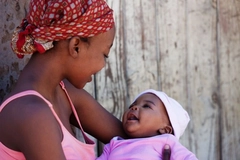WFP warns more than 1.6 million children could face malnutrition as floods hit South Sudan
07 Nov 2023 --- Over one million children in South Sudan are likely to face extreme levels of malnutrition in the first half of 2024 as a result of floods caused by climate change, cautions the World Food Programme (WFP). In light of malnutrition awareness week, the organization is highlighting data from the Integrated Food Security Phase Classification (IPC).
“The key factors contributing to the unprecedented rise in malnutrition include high prevalence of disease and illness (especially among young children), poor access to clean drinking water and sanitation and insufficient food in terms of quality and quantity,” Gemma Snowdon, head of communications for the WFP in South Sudan, tells Nutrition Insight.
Floodwaters have permanently submerged or segregated entire communities since 2021 in Rubkona county in the North-Central region of South Sudan. As a result, community members could face exceptionally high levels and severity of malnutrition by April 2024.
An IPC analysis conducted between September and November 2023 reveals that 46% of the evaluated population of South Sudan — close to six million people — are facing high levels of acute food insecurity and are in need of urgent action.

“Illness is particularly prevalent in flood-affected areas where people are living in crowded camps for displaced families, which not only causes sanitation issues that contribute to the spread of disease but also leaves families vulnerable to water-borne diseases,” Snowdon explains.  Floodwaters have permanently submerged or segregated entire communities in Rubkona county since 2021.
Floodwaters have permanently submerged or segregated entire communities in Rubkona county since 2021.
High levels of acute food insecurity
IPC classifies food insecurity in five phases, from food security to phase five catastrophe.
“Phase five is the highest classification of severity and shows the gravity of the nutrition situation in Rubkona,” says Snowden.
“The IPC itself is a collaboration where humanitarian agencies, government and partners analyze a variety of data, collected by WFP and others, to get a comprehensive view of food security in a country,” explains Snowden.
Of the six million people in South Sudan facing acute food security, more than four million are in crisis (phase three on the IPC scale), while a million and a half are in an emergency (phase four) and 35,000 people are facing a catastrophe (phase five).
The IPC’s first projection for December 2023 to March 2024 is that close to 100,000 more people will be pushed toward a crisis — stage four of food insecurity — while an additional 25,000 are projected to be in phase five, catastrophe.
Impact on children under five
Snowden explains that malnutrition is generally an outcome of prolonged food insecurity. “Normally, we would expect to see a significant deterioration in food security status before a similar worsening in nutrition, but that hasn’t been the case for Rubkona.”
“This suggests that the prevalence of water-borne disease has been a particularly important factor this year, coming on top of the lack of livelihoods and access to food and having a devastating impact on the well-being of the most vulnerable members of society — children under five years.”
“Once children, particularly very young children, become ill, they often have less appetite, and their bodies are less able to absorb nutrients, leaving them vulnerable to malnutrition. Additionally, very few children (only 5%) have an acceptable diet in terms of quality and quantity, so the majority of children in South Sudan are not getting the best start in life when it comes to nutrition.”
The flooding-prone region of Rubkona county, which has been submerged for the past two years, is predicted to reach the highest possible phase five by April 2024 for the first time.
Preventative action
Rubkona county is also dealing with a severe economic shock that has led to the rise of staple food costs by over 120% since April of this year.
“In response to the current crisis, WFP provides critical food and nutrition assistance across South Sudan to stabilize food insecurity. This includes both treatment and preventative actions,” Snowdon explains.  Close to half of South Sudan’s population is currently facing high levels of acute food insecurity and are in need of urgent action.
Close to half of South Sudan’s population is currently facing high levels of acute food insecurity and are in need of urgent action.
“Blanket supplementary feeding is a program where highly nutritious food is provided to young children and pregnant or new mothers to prevent malnutrition, while treatment programs focus on mothers and children who are already malnourished,” the Juba-based WFP representative adds.
“This is the reality of living on the frontline of the climate crisis,” says Mary-Ellen McGroarty, WFP representative to South Sudan. “We’re seeing an extremely concerning rise in malnutrition, which is a direct result of living in overcrowded and waterlogged conditions. The spread of water-borne diseases unravels any work humanitarian agencies do in preventing and treating malnutrition, and it is young children who are suffering the impact most severely.”
The WFP also collaborates with the government and other UN and humanitarian agencies to ensure coordination and to reach as many people as possible.
“Unfortunately, here in South Sudan, we’re seeing a situation where the needs are outpacing the resources,” underscores Snowden.
“The number of people in need of support and the volume of need exceeds what can be covered with the funding we have available for our programs, so we are forced to prioritize and can only reach those facing the most critical levels of hunger and malnutrition.”
By Milana Nikolova
















